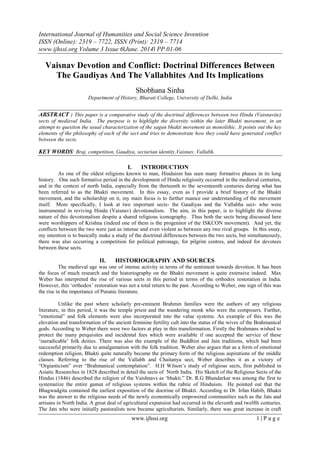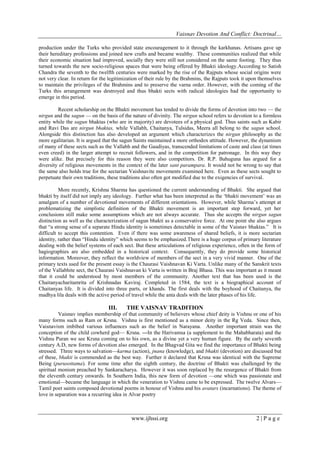This paper examines the doctrinal differences between two Vaisnavite sects, the Gaudiyas and the Vallabhites, highlighting the complexities and conflicts within the Bhakti movement of medieval India. It discusses how these sects, despite worshipping Krishna, competed for devotees and political patronage, leading to intense rivalries. The study emphasizes the rich diversity of beliefs and practices in the Bhakti movement, challenging the notion of a monolithic religious identity.





![Vaisnav Devotion And Conflict: Doctrinal…
www.ijhssi.org 6 | P a g e
Thus one of the causes for the dispute over the Govardhannath temple between the Gaudiyas and the
Vallabhites was the Gaudiya practice of worshipping Radha alongside Krishna. At a broader level, as Paul
Toomey has pointed out while the Vallabhite outlook was structured around the family, the Caitanyites framed
their experiences around a relationship that ―violated‖ the family order. Although this interpretation was
challenged by members of the Gaudiya sect at some point, nevertheless, it was the role of Radha as the lover,
rather than as wife (as some argued she was), which came to be extolled. This was because love which defied all
social conventions was considered to be the purest. On the other hand, the preservation of the family structure
was important to the Vallabhite schema. A majority of their members belonged to god fearing prosperous
mercantile classes who were uncomfortable with the figure of Radha. To an extent, this arrangement was
sought to be modified by Vallabh‘s son Vitthala, possibly as a result of Gaudiya influence. Despite such efforts,
Radha was not able to gain the kind of importance she enjoyed among the Gaudiya devotees, in the Vallabha
sect.The particular theologies formulated by each sect, emphasized a number of devotional practices, which
taken to their logical end would have led to tensions. The specific provision for worship of images required that
each sect appropriate these sacred symbols. The injunction to associate with fellow devotees was a powerful
impulse behind the creation of formal communities. Similarly the instruction to settle in the Braj area fuelled
attempts to establish connections between each of the sects and Braj. This was reflected in the competition for
land grants that occurred in this period. Mughal patronage of Vaisnavite temples, especially in Vrindavan has
been documented. However the Mughal state was not the only political entity which patronized the sects. As
Monika Horstmann has argued, in the context of the disintegration of the Mughal empire and the emergence of
successor states, a Vaisnava oriented stance reinforced by Vedic rituals was utilized by rulers to legitimize the
cosmic and political claims of a Hindu prince to universal rule. Thus the Govinddeva temple received many
grants from the Kacchwaha dynasty of Amber while the Srinathji temple was supported by grants from the
Sisodias. This paper has sought to recover this very competition between two ostensibly similar texts by
analyzing the doctrinal differences between the two.
REFERENCES
[1] Max Weber, The Religion of India (The Sociology of Hinduism and Buddhism) translated by Hans H.Gerth and Don Martindale,
New Delhi, Munshiram Manoharlal Publishers, 1992
[2] H.H Wilson, Religious Sects of the Hindus (ed. By Ernst S Rost) Calcutta Sushil Gupta India Pvt. Ltd. 1958
[3] Bardwell Smith, (ed.) Hinduism- New Essays in the History of Religion Leiden, E.J Brill, 1982
[4] R.P Bahuguna in Biswamoy Pati (ed.) Negotiating India’s Past Delhi, Tulika, 2003
[5] Krishna Sharma in David N Lorenzen, (ed.) Religious Movements in South Asia 600-1800 A, New Delhi, Oxford University
Press, 2004
[6] R.S Mc Gregor, The Round Dance of Krishna and Uddhav’s Message London, Luzac and Company Ltd 1973
[7] Gavin Flood (ed.)The Blackwell Companion to Hinduism Cornwall, Blackwell Publishing, 2003
[8] Richard Barz, The Bhakti Sect of Vallabhacharya New Delhi,Munshiram Manoharlal Publishers, 1992
[9] Richard J. Cohen,‘ Sectarian Vaishnavism: the Vallabha Sampradaya‘ in Peter Gaeffke and David A Utz (ed.) Identity and
Division in Sects and Cults in South Asia, Philadelphia. Universiy of Pennsylvania, 1984
[9] Melville Kennedy, The Chaitanya Movement New Delhi, Munshiram Manoharlal Publishers,
1993
[10] A.W Entwistle, Braj Centre of Krishna Pilgrimage Groningen,Egbert Forsten, 1987
[11] Charlotte Vaudeville, Myths, Saints and Legends in Medieval India New Delhi, Oxford University Press, 1996](https://image.slidesharecdn.com/a03630106-140714001906-phpapp01/85/A03630106-6-320.jpg)